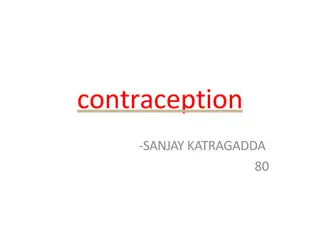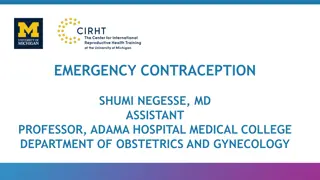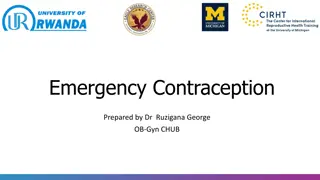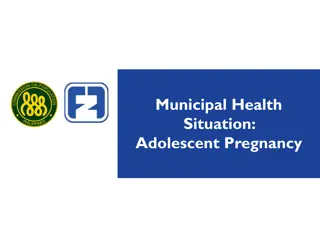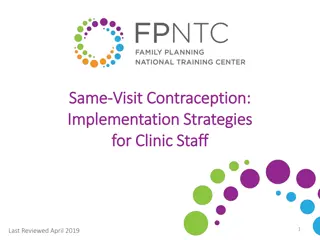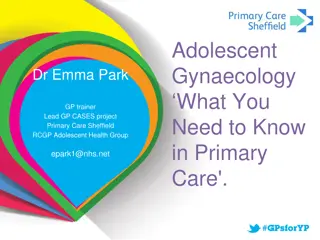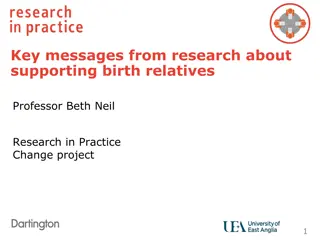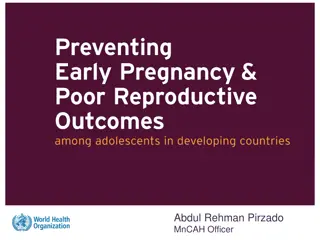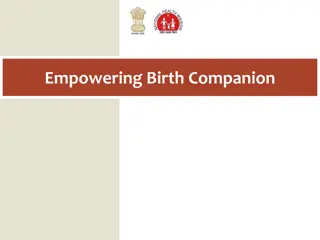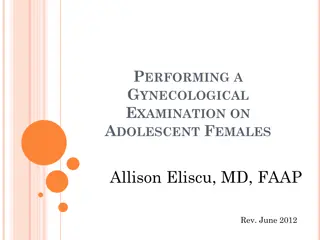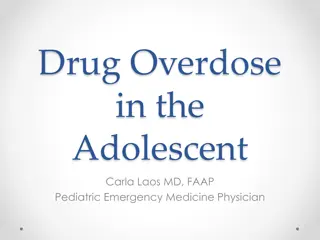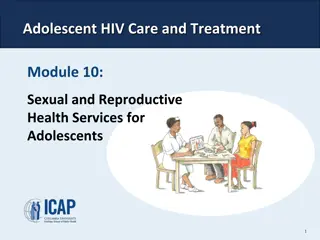Adolescent Contraception Guidelines: Initiating and Managing Birth Control
Adolescents have unique considerations when it comes to contraception. From discussing various methods such as hormonal and barrier options to when to start contraception, emphasis is on educating healthcare providers to provide appropriate guidance to this age group. Understanding the importance of contraception in adolescence, considerations before initiating contraception, and optimal contraceptive plans for adolescents are crucial for effective management. The content covers essential aspects like the quick-start method, starting contraception based on the menstrual cycle, and the significance of regular use. By prioritizing education and communication, healthcare providers can empower adolescents to make informed decisions regarding their sexual health.
- Adolescent contraception
- Birth control guidelines
- Hormonal methods
- Barrier methods
- Quick-start method
Uploaded on Sep 09, 2024 | 0 Views
Download Presentation

Please find below an Image/Link to download the presentation.
The content on the website is provided AS IS for your information and personal use only. It may not be sold, licensed, or shared on other websites without obtaining consent from the author. Download presentation by click this link. If you encounter any issues during the download, it is possible that the publisher has removed the file from their server.
E N D
Presentation Transcript
birth_control_250x251 CONTRACEPTION IN ADOLESCENTS Allison Eliscu, MD, FAAP Rev. Aug 2012
copperpto Male Condom Oral Contraceptive IUD CONTRACEPTIONIN ADOLESCENTS NuvaRing Depo Provera FemaleCondom Birth Control Patch
THE IMPORTANCEOF CONTRACEPTIONIN ADOLESCENCE Average age of sexual debut is 16 47% of U.S. high school students are sexually active 62% used condoms at last sexual event 16% used OCPs at last sexual event 35% of teens do not use contraception at first intercourse Average time between initial intercourse and medical visit for contraception is 12 months!
CONSIDERATIONS BEFORE INITIATING CONTRACEPTIONWITH ADOLESCENTS Pelvic Exam Not required if asymptomatic for STIs (may be recommended) Pap Smear Not indicated unless 21 years old Changed from prior guidelines in 2009 (see notes below for explanation) Emphasize condom use Hormonal contraceptives do not prevent STIs Discuss emergency contraception Consider advance prescriptions
WHEN TO START CONTRACEPTION 1. QuickStart Method (Preferred) Patient starts method the day she gets the medication Must do pregnancy test if she is not on menses May increase compliance Requires back-up method for 1st month as ovulation may have already occurred
WHEN TO START CONTRACEPTION 1. QuickStart Method (Preferred) 2. First day of menses Easy for patients to remember May have decreased compliance if patients forget to start May have irregular bleeding for first month
WHEN TO START CONTRACEPTION 1. QuickStart Method (Preferred) 2. First day of menses 3. Sunday after menses starts Frequent confusion about which day to actually start Decreased irregular bleeding in initial month
OPTIMAL ADOLESCENT CONTRACEPTIVE PLAN Hormonal Method Barrier Method AND
HORMONAL CONTRACEPTION OPTIONS Estrogen and progesterone containing products Combined oral contraceptive Patch (OrthoEvra) NuvaRing Progesterone-only products Oral progestin (mini-pill) Depo Provera Mirena (Levonorgesterol IUD) Implanon (Long acting implant)
Combined Estrogen and Progesterone Containing Products
COMBINED ESTROGENAND PROGESTIN MECHANISMOF ACTION Blocks LH and FSH Inhibits ovulation Thickens cervical mucus to prevent sperm penetration Inhibits capacitation of sperm
ESTROGENAND PROGESTERONE NONCONTRACEPTIVE BENEFITS Menstrual-related effects Regularity of cycles Decreased dysmenorrhea Decreased blood loss May decrease PMS symptoms Decreased anemia Improved acne and hirsutism Reduced risk of Ectopic pregnancies Endometrial and ovarian cancer risk Benign breast conditions (i.e.: fibrocystic change) PID
ESTROGENAND PROGESTERONE ADVERSE EFFECTS Nausea* Vomiting* Breast tenderness* Elevated blood pressure Headaches Abdominal bloating Mood changes (irritability, depression, anxiety) *These effects usually resolve within 3 months Not Associated with Significant Weight Gain
RARE ESTROGEN-RELATED HEALTH RISKS Screen for ACHES at follow-up visits: Blood clot in liver or pelvis Benign liver tumor Gall bladder disease Abdominal pain Chest pain Pulmonary embolus Angina/heart attack Stroke Migraine headache High blood pressure Headaches Stroke Migraine headache Retinal vessel embolus Eye or visual changes Severe leg pain or swelling Deep vein thrombosis
EFFICACYOF COMBINED CONTRACEPTION Perfect use: 0.3% failure (pregnancy) rate in 1 year Typical adult use: 8% failure rate Typical adolescent use: 5-25% failure rate Due to poor adherence *Compared to failure rate of 85% with no contraception (85% of sexually active women become pregnant in 1 year when no contraception is used)
Combined Oral Contraceptives Contains estrogen and progesterone Requires taking pill daily Efficacy decreases with missed pills Typically taken for 21 days Menses during 7 day of placebo pills
Continuous Oral Contraceptives Monophasic pill taken consecutively for longer than 28 days Benefits Risks Amenorrhea Decreased PMS Symptoms Decreased dysmenorrhea Beneficial in endometriosis Contraceptive benefit equal to 28-day pill Break through bleeding Long term effects of continuous estrogen unknown Seasonale84 active pills + 7 placebo pills (4 menses/year) Lybrel 28 active pills only (no menses/year)
Contraceptive Patch (OrthoEvra) Patch releases estrogen and progestin through skin New patch applied weekly for 3 weeks Menses in patch-free week (week 4) Change location with each patch Back-up method required if patch in place >9 days
Contraceptive Patch Advantages Efficacy comparable to oral contraceptives Weekly use improves compliance Disadvantages Application site reactions (irritation or hyperpigmentation) Possibly less effective in patients over 198 pounds Higher detachment rate in teens May be visible to others FDA concerns about the increased rate of thromboembolism
Blood Clot Risk Keep it in Perspective Risk in General Population: 0.8 per 10,000 women per year Risk in Women Using Oral Contraception: 3 4 per 10,000 women per year Risk in Women Using Contraceptive Patch 4-5 per 10,000 women per year Pregnancy and Postpartum Period: 6 12 per 10,000 women per year 60% higher estrogen exposure with patch use compared to oral contraceptive
Contraceptive Patch Safe and effective product in low risk patients Appropriate risk/benefit profile (per FDA) Better alternative than getting pregnancy
NuvaRing Soft, flexible ring placed in vagina Does not need to cover cervix or be in specific position Remains in place for 3 weeks Menses during 7 day withdrawal (no ring in place) Significantly lower serum estrogen levels
NuvaRing Advantages Lower rates of breakthrough spotting Lower rates of systemic side effects 3 week use increases compliance High rates of patient satisfaction Disadvantages Requires insertion by adolescent May cause vaginal irritation or discharge Occasional expulsion May have foreign body sensation or coital problem Very few partners object to Ring use based on coital problems
Progesterone Methods Mechanism of Action Decreased GnRH pulse frequency Ovulation inhibited Endometrial hypoplasia Cervical mucus thickened
Depot Medroxyprogesterone Acetate (Depo Provera) 150mg IM injection every 12 weeks Usually initiated within first 5 days of menses May QuickStart if pregnancy test is negative Repeat urine HCG in 2-3 weeks if quickstart Likely prevents ovulation for 14 weeks (2 week grace period) Failure (pregnancy) rate 0.3% *GREAT METHOD FOR ADOLESCENTS*
Depo Provera Advantages 3 month schedule improves adherence Contraceptive option when estrogen is contraindicated Decreases risk of endometrial cancer and PID May increase seizure threshold Safe for breastfeeding and postpartum women Extremely effective Disadvantages Weight gain Irregular bleeding Amenorrhea Depression and mood changes Decreased bone mineral density Likely reversible after discontinuation
Progesterone Only Pill (Mini Pill) Same pill daily without placebo pills Alternative when estrogen contraindicated Must take consistently at same time of day Break through ovulation possible if delayed > 2-3 hours (may get pregnant if pill delayed >3 hours) *NOT A GOOD METHOD FOR ADOLESCENTS*
Levonorgesterol-Releasing Intrauterine Device (Mirena) Releases 20mcg/day of progesterone into endometrium FDA approved for up to 5 years Inserted during menses or after spontaneous or induced abortion since cervix is open Failure (pregnancy) rate 0.2% in 1 year *EXCELLENT METHOD FOR ADOLESCENTS!*
Mirena IUD Advantages Decreased menstrual bleeding Decreased dysmenorrhea Frequently develop amenorrhea Systemic adverse effects are rare Contraceptive option when estrogen contraindicated Alternative for breastfeeding women Disadvantages Spotting common (especially in first 6 months) Cramping pain with placement
Mirena IUD Dispelling Myths IUDs are NOT contraindicated in adolescents Reliable method Excellent, long-term protection Low risk of systemic side effects Slight increase risk of PID for 3 weeks after insertion After 3 weeks, risk of PID is equal to that of an adolescent without IUD Do not place IUD if patient has cervicitis or PID currently or within past 3 months BUT, overall risk of getting pregnant with IUD is incredibly low IUDs do NOT increase the risk of PID IUDs do NOT increase the risk of ectopic pregnancies If pregnancy occurs with IUD in place, likely to be ectopic IUDs do NOT affect fertility after removal
IMPLANON Single rod containing progesterone Inserted under skin of inner upper arm Effective within 24 hours of insertion Small incision for removal Local anesthesia may be used for insertion and removal Approved for 3 year use
Implanon Advantages Effective within 24 hours of insertion Fertility returns rapidly after removal Decreased menstrual bleeding (amenorrhea possible) Decreased dysmenorrhea Disadvantages Requires provider insertion and removal Break-through bleeding possible Adverse effects possible Headache, acne, mood changes, weight gain
NONHORMONAL METHODS CONTRACEPTION Female Condom Polyurethane sheath with 2 rings May be inserted hours before intercourse Can be used by latex allergic individuals May be noisy and uncomfortable Failure (pregnancy) rate: Typical use: 21-26%, Perfect use: 5% Male Condom Provides protection against STDs and pregnancy Occasionally slips (2%) or breaks (2%) May interfere with spontaneity Most inexpensive and cost effective method of protection Failure (pregnancy) rate: Typical use: 12%, Perfect use: 3% birth_control_250x251
CONTRACEPTIVE METHODS NOT RECOMMENDED FOR ADOLESCENTS Withdrawal Low efficacy rate STI risk Relies entirely on male partner, female has no control Sterilization Irreversible Calendar/Natural Planning Method Low efficacy rate STI risk Irregular cycles in adolescents make timing of ovulation more difficult and less predictable
CONTRACEPTIVE METHODS NOT RECOMMENDED FOR ADOLESCENTS Copper T IUD (ParaGard) Increased menstrual bleeding and cramping may not be tolerated Lactation Not reliable unless: Less than 6 months postpartum Amenorrheic Breastfeeding exclusively Must meet all 3 conditions to be effective
EMERGENCY CONTRACEPTION Levonorgesterol 0.75 mg tabs x 2 together Progesterone only (contains NO estrogen) Can use up to 120 hours (5 days) after unprotected sex (more effective the sooner it s used) Recommend empiric use after sexual assault Available over-the-counter for individuals 17 years old Consider giving advance prescription to adolescents Especially to patients relying on condoms alone
EMERGENCY CONTRACEPTION Possible method of action Inhibits or delays ovulation Does not interrupt current pregnancy Not teratogenic Effectiveness <24 hrs 95% pregnancy reduction Within 72 hours 89% pregnancy reduction More effective the sooner it s taken
A 17 year old female present to the office asking to start on birth control. She is currently monogamous with a male partner, using condoms most of the time, and has had 3 male partners in the past. She has never had a gyn exam and is currently asymptomatic. She has regular monthly menses and her last period started 1 week ago. She is interested in starting pills with her next menses. Which of the following must be done before starting on the pill? A. Obtain consent from a parent B. Perform a gyn exam with pap smear C. Perform an HIV test D. None of the above
A 17 year old female present to the office asking to start on birth control. She is currently monogamous with a male partner, using condoms most of the time, and has had 3 male partners in the past. She has never had a gyn exam and is currently asymptomatic. She has regular monthly menses and her last period started 1 week ago. She is interested in starting pills with her next menses. Which of the following must be done before starting on the pill? A. Obtain consent from a parent B. Perform a gyn exam with pap smear C. Perform an HIV test D. None of the above
Answer: E. None of the listed entities must be performed prior to starting birth control. A sexually active 17 year old female should be encouraged to receive STI testing, either by endocervical swab or urine testing. All sexually active females under the age of 25 should receive annual STI screening, however this is not required before beginning contraception. In the past, providers used to require a gynecological exam prior to dispensing birth control but this became an obstacle for teens who wanted to acquire contraception. Although an initial gyn exam may be recommended (for STI screening, to get the patient used to the exam, to screen for skin lesions, etc.), it is no longer a requirement prior to beginning contraception. The newest ACOG guidelines* recommend delaying the initial pap smear until 21 years of age, regardless of when sexual intercourse was first initiated. So this patient should not receive a pap smear at this time. The patient in the vignette has regular menses and is planning on beginning the pill with her next menses so a pregnancy test is not required. If she had irregular menses or wanted to quickstart the pill (meaning begin the pill in the middle of her cycle rather than waiting for her next menses), then she would require a pregnancy test first. An HIV test may be offered to the patient but is also not required. Additionally, adolescents are able to obtain contraception without parental consent.
Which of the following statements about the use of contraception among adolescents is TRUE? A. Adolescents typically consult a physician for contraceptive advice before becoming sexually active B. The progestin-only pill (mini pill) is a good contraceptive alternative for adolescents since pregnancy is prevented even if pills are occasionally forgotten C. Depo provera is a potential option for an adolescent female who is breastfeeding D. Adolescents who are abstinent do not require anticipatory counseling about contraception since it may encourage them to become sexually active E. None of the above are true
Which of the following statements about the use of contraception among adolescents is TRUE? A. Adolescents typically consult a physician for contraceptive advice before becoming sexually active B. The progestin-only pill (mini pill) is a good contraceptive alternative for adolescents since pregnancy is prevented even if pills are occasionally forgotten C. Depo provera is a potential option for an adolescent female who is breastfeeding D. Adolescents who are abstinent do not require anticipatory counseling about contraception since it may encourage them to become sexually active E. None of the above are true
Answer: C. Lactating women may use progesterone-only methods of contraception such as the mini-pill or depo provera. Estrogen should not be used in the immediate postpartum period due to an intrinisic increased risk of clotting during that time. Additionally, estrogen can decrease a woman s milk supply making it harder to breastfeed. Adolescents generally do not consult a physician regarding contraception before initiating intercourse. In fact, they tend to wait 6-12 months between initiating intercourse and seeking contraception which is why anticipatory counseling should be discussed before females become sexually active. Discussing contraception beforehand does not make a person more likely to engage in intercourse but may increase the chance of using protection at the initial episode. The progesterone-only pill is not a good contraceptive choice for adolescents since break-through ovulation can occur if it is delayed by more than 2 hours.
A 16 year old female is interested in starting depo provera. Which of the following statements about depo is NOT true? A. Weight gain is a common side effect of depo B. Depo use may increase a person's chance of developing a blood clot C. Bone mineral density may decrease with depo use D. Women frequently stop using depo because of irregular spotting E. It may take 6-12 months for a female to regain normal menstrual cycles after stopping depo
A 16 year old female is interested in starting depo provera. Which of the following statements about depo is NOT true? A. Weight gain is a common side effect of depo B. Depo use may increase a person's chance of developing a blood clot C. Bone mineral density may decrease with depo use D. Women frequently stop using depo because of irregular spotting E. It may take 6-12 months for a female to regain normal menstrual cycles after stopping depo
Answer: B. Females using estrogen-containing methods of contraception have a slightly increased risk of developing blood clots. These methods include the combined pill, patch, and nuvaring. Depo provera contains progesterone only so there is no increased risk of developing a clot. Side effects of depo include weight gain, irregular spotting, amenorrhea, hair loss, and mood changes. Additionally, bone mineral density is frequently decreased with depo use but this is likely reversible within 2 years of stopping depo. Resumption of normal menses and fertility may take 6-12 months after stopping depo.
You are counseling a sexually active 15 year old female about contraception. Which of the following is a true statement which you may include in your conversation? A. Noncontraceptive benefits of oral contraceptives include improved acne and dysmenorrhea B. IUD is not a good method for adolescents due to an increased risk of pelvic inflammatory disease (PID) in young women C. Nuvaring is not popular among adolescents since you must be fitted for a nuvaring and have it placed monthly by a provider D. The contraceptive patch is associated with a lower risk of developing a blood clot compared to depo provera E. Both A & B are true
You are counseling a sexually active 15 year old female about contraception. Which of the following is a true statement which you may include in your conversation? A. Noncontraceptive benefits of oral contraceptives include improved acne and dysmenorrhea B. IUD is not a good method for adolescents due to an increased risk of pelvic inflammatory disease (PID) in young women C. Nuvaring is not popular among adolescents since you must be fitted for a nuvaring and have it placed monthly by a provider D. The contraceptive patch is associated with a lower risk of developing a blood clot compared to depo provera E. Both A & B are true
Answer: A. All estrogen-containing contraceptives (combined pill, patch, and nuvaring) have noncontraceptive benefits including decreased dysmenorrhea, more predictable menses, decreased blood loss with menses, and improved acne and hirsutism. The IUD is an excellent method for adolescents since it may be in place for a long period of time and does not require them to remember to take something daily or weekly. The Mirena and ParaGard are not associated with an increased risk of PID outside of the initial period 3 weeks immediately after insertion. Nuvaring is also a good method for adolescents since it remains in place for 3 weeks at a time. Unlike a diaphragm, nuvarings do not have to be fitted by a provider, there is only 1 size of nuvaring available. Unlike an IUD, nuvarings are inserted and removed by the patient. Finally, the contraceptive patch is associated with a higher risk of developing a blood clot compared to the other estrogen-containing contraceptives (combined pill and nuvaring) as well as the progesterone-only methods (such as depo). This is because of the elevated serum level of estrogen in a female on the patch.



